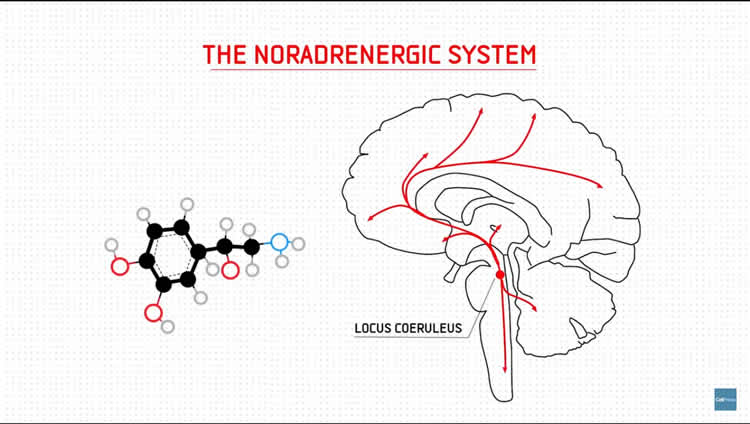Summary: A new study reveals noradrenaline plays a vital role in early stages of perception. Researchers report later processing of visual information occurs in the cerebral cortex and is affected by noradrenaline to determine if an image will enter our stream of consciousness.
Source: AFTAU.
Being aware of our surroundings is a fundamental aspect of our existence. But what in our biological makeup determines how we access and interpret the endless stream of information around us?
A new Tel Aviv University study published in Current Biology suggests that noradrenaline, a neurotransmitter responsible for arousal in the brain, plays a vital role in our early sensory perceptions of the world.
“Until now, medical science believed that noradrenaline is involved in alertness, stress, attention and decision making,” says senior author Dr. Yuval Nir, of TAU’s Sackler Faculty of Medicine and Sagol School of Neuroscience. “Our study shows that, in fact, noradrenaline plays a vital role in earlier stages of perception, determining our ability to perceive events around us.”
The research was jointly led by Dr. Hagar Gelbard-Sagiv and Efrat Magidov of TAU’s Sackler Faculty of Medicine and Sagol School of Neuroscience, in collaboration with Dr. Haggai Sharon and Prof. Talma Hendler of TAU and the Sagol Brain Institute at Tel Aviv Medical Center.
The scientists ran a series of experiments on 30 participants at the Sagol Brain Institute at Tel Aviv Medical Center. Subjects took part in three different sessions in which they received (1) drugs that lowered noradrenaline levels; (2) drugs that increased those levels; or (3) a placebo. After taking the medication, the participants were asked to perform visual tasks such as detecting and discriminating between low-contrast images, while the researchers measured their brain activity by EEG or fMRI. The researchers hoped to determine how various levels of noradrenaline affected visual perception and the way the brain responds to images.

“We determined that noradrenaline affected the participants’ ability to detect low-contrast images. Even though the images were identical in each case, their visibility changed across sessions. We could predict whether the subjects could perceive those images by examining the levels of noradrenaline in their systems,” says Dr. Gelbard-Sagiv.
“Our measurements of brain activity show that the first stages of visual processing are quite automatic, but late processing in the cerebral cortex is affected by noradrenaline and determines if an image will enter our stream of consciousness,” adds Magidov.
“Many people suffer from difficulties in initiating and maintaining sleep,” Dr. Nir concludes. “We hope to follow up on these results and test whether noradrenaline also determines if sensory stimuli such as sounds wake us up from sleep.
“We hope that in the future our findings will open new avenues for the development of better anesthetics and new tools for early detection of dangerous situations, such as lapses while driving or flying.”
Funding: National Institutes of Health, David M. Rubenstein Hearing Center funded this study.
Source: George Hunka – AFTAU
Publisher: Organized by NeuroscienceNews.com.
Image Source: NeuroscienceNews.com image is adapted from the Cell Press video.
Video Source: Video credited to Cell Press.
Original Research: Open access research for “Noradrenaline Modulates Visual Perception and Late Visually Evoked Activity” by Hagar Gelbard-Sagiv, Efrat Magidov, Haggai Sharon, Talma Hendler, and Yuval Nir in Current Biology. Published July 5 2018.
doi:10.1016/j.cub.2018.05.051
[cbtabs][cbtab title=”MLA”]AFTAU”Noradrenaline Plays a Critical Role in Sensory Perception.” NeuroscienceNews. NeuroscienceNews, 10 July 2018.
<https://neurosciencenews.com/noradrenaline-sensory-perception-9546/>.[/cbtab][cbtab title=”APA”]AFTAU(2018, July 10). Noradrenaline Plays a Critical Role in Sensory Perception. NeuroscienceNews. Retrieved July 10, 2018 from https://neurosciencenews.com/noradrenaline-sensory-perception-9546/[/cbtab][cbtab title=”Chicago”]AFTAU”Noradrenaline Plays a Critical Role in Sensory Perception.” https://neurosciencenews.com/noradrenaline-sensory-perception-9546/ (accessed July 10, 2018).[/cbtab][/cbtabs]
Abstract
Noradrenaline Modulates Visual Perception and Late Visually Evoked Activity
Highlights
•Noradrenergic drugs modulate sensitivity and accuracy of human visual perception
•Noradrenaline increases the fidelity of late EEG visual responses
•Noradrenaline selectively modulates BOLD fMRI responses in high-order visual cortex
•NE is a key factor causally linking visual awareness to external world events
Summary
An identical sensory stimulus may or may not be incorporated into perceptual experience, depending on the behavioral and cognitive state of the organism. What determines whether a sensory stimulus will be perceived? While different behavioral and cognitive states may share a similar profile of electrophysiology, metabolism, and early sensory responses, neuromodulation is often different and therefore may constitute a key mechanism enabling perceptual awareness. Specifically, noradrenaline improves sensory responses, correlates with orienting toward behaviorally relevant stimuli, and is markedly reduced during sleep, while experience is largely “disconnected” from external events. Despite correlative evidence hinting at a relationship between noradrenaline and perception, causal evidence remains absent. Here, we pharmacologically down- and upregulated noradrenaline signaling in healthy volunteers using clonidine and reboxetine in double-blind placebo-controlled experiments, testing the effects on perceptual abilities and visually evoked electroencephalography (EEG) and fMRI responses. We found that detection sensitivity, discrimination accuracy, and subjective visibility change in accordance with noradrenaline (NE) levels, whereas decision bias (criterion) is not affected. Similarly, noradrenaline increases the consistency of EEG visually evoked potentials, while lower noradrenaline levels delay response components around 200 ms. Furthermore, blood-oxygen-level-dependent (BOLD) fMRI activations in high-order visual cortex selectively vary along with noradrenaline signaling. Taken together, these results point to noradrenaline as a key factor causally linking visual awareness to external world events.







